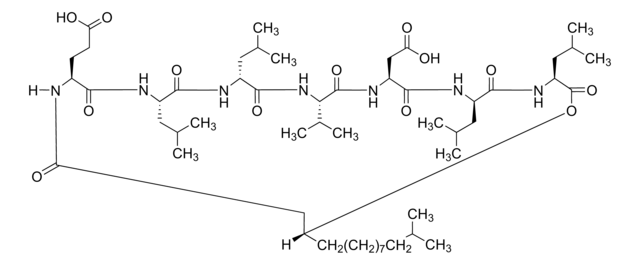R95MD
Rhamnolipids
95% (Mono-Rhamnolipid dominant)
Synonim(y):
Rhamnolipids
About This Item
Polecane produkty
product name
Rhamnolipids, 95% (Mono-Rhamnolipid dominant),
pochodzenie biologiczne
Pseudomonas aeruginosa
Poziom jakości
Postać
solid/granular
charakterystyka ekologicznej alternatywy
Design for Degradation: Greener alternative product characteristics
Learn more about the Principles of Green Chemistry.
sustainability
Greener Alternative Product
kategoria ekologicznej alternatywy
, Aligned
Warunki transportu
ambient
temp. przechowywania
room temp
Szukasz podobnych produktów? Odwiedź Przewodnik dotyczący porównywania produktów
Opis ogólny
We are committed to bringing you Greener Alternative Products, which adhere to one or more of The 12 Principles of Greener Chemistry. This product has been enhanced for hydrocarbon degradation. For more information see the paper Environmental applications of biosurfacants: recent advances, and the many other articles available at: AGAE Technologies
Zastosowanie
Rhamnolipids are environment friendly and biologically safe surfactants that can kill enveloped viruses. A recent study has shown 222B (10% aqueous solution made with mono-rhamnolipid predominant product R95MD) can be coated on masks to prevent or reduce the spread of enveloped viruses. Click here for more information.
Informacje prawne
Kod klasy składowania
11 - Combustible Solids
Temperatura zapłonu (°F)
Not applicable
Temperatura zapłonu (°C)
Not applicable
Certyfikaty analizy (CoA)
Poszukaj Certyfikaty analizy (CoA), wpisując numer partii/serii produktów. Numery serii i partii można znaleźć na etykiecie produktu po słowach „seria” lub „partia”.
Masz już ten produkt?
Dokumenty związane z niedawno zakupionymi produktami zostały zamieszczone w Bibliotece dokumentów.
Nasz zespół naukowców ma doświadczenie we wszystkich obszarach badań, w tym w naukach przyrodniczych, materiałoznawstwie, syntezie chemicznej, chromatografii, analityce i wielu innych dziedzinach.
Skontaktuj się z zespołem ds. pomocy technicznej







